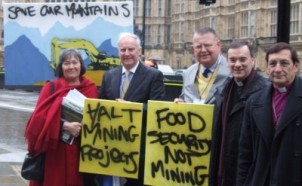
By Joan Martinez-Alier
Robert Goodland, a Canadian ecologist, was a specialist in tropical ecology. He died on 28 December 2013. In 1974 he authored a landmark book on the Amazon, From green hell to red desert. I knew Robert Goodland since 1988, when he brought Herman Daly to the World Bank and was active in the International Society for Ecological Economics.
For many years he did what he could inside the World Bank to prevent damage to the environment and to poor people. He gave guidelines and tried to stop many mining projects and many dams. When he retired, he got really going: helping environmental groups around the world until his recent death. He wrote, for instance, a scathing report on Alcan’s involvement in bauxite mining in Kashipur, Odisha that led to Alcan leaving the project. He fought for environmental justice using the knowledge and authority he had accumulated over many years.
In November 2013, a few weeks before his death, he wrote to me on Chico Mendes’ 25th anniversary, “We had an excellent Chico Mendes evening at American Univ recently, also honored Adrian Cowell’s work. Now we are having another two events on Chico, one in a Church on 22 Dec, and the other also somewhere in American University”.
He was now working on the Pacific Rim Gold Mining Corp vs El Salvador lawsuit to be heard by ICSID possibly in 2014. It was ominous because PacRim had declared bankruptcy. It had been bought up recently by a far worse mining corporation called OceanaGold Corporation which had done human rights abuses, tax fraud, bloodshed against indigenous peoples etc. in their gold/copper mine in Ifugao territory in the Philippines.
Oceana in Ifugao territory in the Philippines
Robert Goodland sent the following notes on his work in progress, which I think he would have wanted to make public. He wrote that OceanaGold Corp had bought up Pacific Rim, a Canadian company from Vancouver, owning El Dorado mine. OceanaGold claimed that its Didipio gold/copper mine in the Philippines was a model; now OceanaGold had acquired PacRim, OceanaGold’s track record of human rights abuses and environmental violations must be expected to be replicated in El Salvador.
Since 1988, Australian/Canadian Oceana Gold had already invested $200 million to develop its 37,000 ha concession of the Didipio Gold-Copper Mining Project in the Philippines, expected to produce 120,000 ounces of gold and 15,000 tonnes of copper concentrate a year in the first 10 years of production, with a minimum life of 15 years. Because of bloodshed, the Army arrived in 1994, where they remain. Forced evictions concerned mainly Ifugao Indigenous Peoples and a village of 200 houses was bulldozed. After a slow start-up, commercial production began in April 2012. The entire Dinkidi hill had been removed for the open-pit mine, ruining forests, terraced rice and orchards. Failure to comply with local government-set requirements for operations prompted local officials to shut it down in July 2013. Especially bad were the human rights violations complaints filed against its security personnel, including killing the councillor. In December 2012, the Department of Justice (DOJ) ordered a manhunt for a militia leader who is suspected of killing anti-mining activist Datu Jimmy Liguyon. Environmental groups led by Kalikasan-PNE (People’s Network for the Environment) however, criticized the Appeals Court order: “The entry of OceanaGold is the root cause of tension and violence among Ifugao communities in Dipidio.”Wildlife had vanished, river fish had died, water supply was toxic. The Commission on Human Rights recommended the revocation of the Financial and Technical Assistance Agreement (FTAA) issued to foreign mining company Oceana Gold Philippines (OGPI) for the firm’s alleged violation of the rights of the Indigenous People of Barangay Didipio in Kasibu, Nueva Vizcaya.The Ifugao Indigenous Peoples, including several subgroups such as the Banaue, Bunhran, Mayayao, Halipan, Hapao, and Kiangang are famous worldwide for practicing fully sustainable terraced rice cultivation. These millennial rice terraces are such valuable patrimony that they were adopted as a United Nation World Heritage site in 1995.


